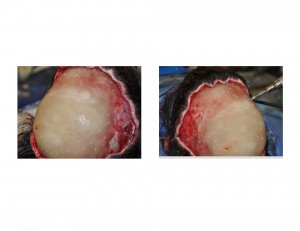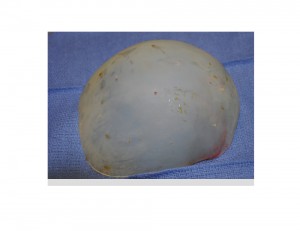Aesthetic cranioplasty often involves the coverage of large skull areas with alloplastic material. Whether it be PMMA or hydroxyapatite cements or with today’s custom 3D generated silicone implants, a fairly large amount of material can serve as a solid interface between the overlying scalp and the underlying cranial bone. As the scalp has an excellent blood supply through major arterial pedicles, the placement of such skull implants do not pose any vascular compromise to the scalp tissues in general or to hair growth in particular.
But there are risks to consider in the use of larger skull implants such as scalp tissue adherence and the development of seromas (fluid collections) after surgery. It is easy to see how these might occur since the scalp normally sticks back down to bone and seals its lymphatic channels by such healing. Any implant material, however, creates a surrounding capsule to which the scalp sticks but the capsule itself does not adhere to the material as firmly as natural scalp tissue sticks to bone. The capsule itself can also be a source of chronic fluid egress particularly in secondary surgery where an established capsule exists.


The placement of perfusion holes in aesthetic skull implants, in addition to recreating a vascular connection, also serves to have a quilting effect. With the tissue ingrowth through the holes, a small soft tissue ‘anchor’ is created. This in effect takes a large subcapsular space around the implant and turns it into many smaller compartments. This serves not only to anchor the overlying scalp to the implant but also can have a seroma prevention effect.
Dr. Barry Eppley
Indianapolis, Indiana


